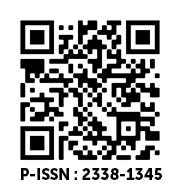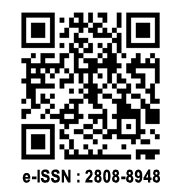Exposure to Ammonia Concentration from the Processing of Crumb Rubber on Environmental Quality: A Review
DOI:
https://doi.org/10.36782/apjsafe.v10i1.127Keywords:
ammonia, crumb rubber, environmental quality, human health, natural rubberAbstract
Nowadays, processed natural rubber products such as crumb rubber have become the demands of global consumers who are oriented towards export markets. Therefore, the economic impact is felt more, but there are still other consequences. The consequences are not only economically beneficial but can also be detrimental to environmental conditions. The process of making natural rubber into crumb rubber causes a negative impact by means of air pollution in the form of odour, which is rarely noticed. The purposes of this study were to analyse the ammonia concentration resulting from the processing of natural rubber into crumb rubber, and to identify the impact of ammonia contamination on the environment, particularly human health. This research was conducted using a review method with the help of colandr machine learning. The results of the review show that the concentration of ammonia produced from the processing of natural rubber into crumb rubber in Indonesia has passed the specified quality standard threshold. It is found to impact the environment such as damage to aquatic ecosystems and air quality, as well as effects on human health such as respiratory problems.
Downloads
References
Central Bureau Statistics of Indonesia. (2021).
Association of Natural Rubber Producing Countries (ANRPC). 2021. Direktorat Jenderal Perdangan Internasional Indoensia, Jakarta.
Angraini, S., Pinem, J. A., Saputra, E. S. 2019. Pengaruh Kecepatan Pengadukan dan Tekanan Pemompaan pada Kombinasi Proses Koagulasi dan Membran Ultrafiltrasi dalam Pengolahan Limbah Cair Industri Karet. Jom FTEKNIK, 3(1), 1–9.
Sari Dewi, D., Eko Prasetyo, H., Karnadeli, E. 2020. Pengolahan Air Limbah Industri Karet Remah (Crumb Rubber) Dengan Menggunakan Reagen Fenton. Jurnal Redoks, 5(1), 47. https://doi.org/10.31851/redoks.v5i1.4120.
Nainggolan, A. 2019. Program studi s1 kesehatan masyarakat fakultas kesehatan masyarakat universitas sumatera utara.
Andriani, Y., Sari, I. R. J., Fatkhurrahman, J. A., Harihastuti, N. 2019. Potensi Cemaran Lingkungan Di Industri Karet Alam Crumb Rubber. Prosiding SNPBS (Seminar Nasional Pendidikan Biologi Dan Saintek) Ke-4, 445–451.
Utomo, T. P., Hasanudin, U., Suroso, E. 2010. Comparative study of low and high-grade crumb rubber processing energy. WCE 2010 - World Congress on Engineering, 2449–2453.
Nurhayati, C., Hamzah, B., Pambayun, R. 2013. Optimasi pengolahan limbah cair karet remah menggunakan mikroalga indigen dalam menurunkan kadar bod, cod, tss liquid. Jurnal Dinamika Penelitian Industri, 24(1), 16–26.
Susilawati, N., Daud, D. 2018. Efisiensi Unit Pengolah Limbah Industri Crumb Rubber di Sumatera Selatan. Prosiding Seminar Nasional Hasil Litbangyasa Industri II, 1(1), 66–73.
Gapkindo. 1992. Rencana Pengendalian Pencemaran Limbah Crumb Rubber. Jakarta.
Utomo, Tanto Pratondo, Nawansih, O., Komalasari, A., Jurusan, D., Hasil, T., Pertanian, F., Lampung, U. 2015. Penentuan jenis outlet untuk pertumbuhan mikroalga Utomo et al Utomo et al Penentuan jenis outlet untuk pertumbuhan mikroalga. Jurnal Teknologi Industri & Hasil Pertanian, 20(2), 109–120.
State Minister for the environment and Forestry of Indonesia, 2014.
Yani, M., Ismayana, A., Nurcahyani, P. R., Pahlevi, D. 2012. Penghilangan Bau Amoniak Dari Tempat Penumpukan Leum Pada Industri Karet Remah Dengan Menggunakan Teknik Biofilter. Jurnal Ilmu Pertanian Indonesia, 17(1), 58–64.
Hakim, A. R., Citra, Fauzi, M. D. N. 2019. Industri Pengolahan Karet di Indonesia.
Marlita, D., Nlql, V., Gdq, N., Dnledw, N., Whumdglq, G., Xgdud, D. S., Nhqgduddq, N. 2014. Pencemaran Udara Akibat Emisi Gas Buang Kendaraan Bermotor. 01(03).
Ratnani, R. D. 2008. Teknik pengendalian pencemaran udara yang diakibatkan oleh partikel. Teknik Pengendalian Pencemaran Udara Yang Diakibatkan Oleh Partikel, 4 No 2, 27–32.
Saputra, A., Irfannuddin, I., Swanny, S. 2018. Pengaruh Paparan Gas Amonia Terhadap Perubahan Kadar Serum SGOT dan SGPT pada Kelompok Berisiko. Biomedical Journal of Indonesia: Jurnal Biomedik Fakultas Kedokteran Universitas Sriwijaya, 4(1), 32–39. https://doi.org/10.32539/bji.v5i1.7956.
Yuwono, A. S. 2008. Odor Quantification and Odor Pollution in Indonesia. Jurnal Purifikasi, 9(2), 175–186.
Sari, M., Muntalif, BS, & Suwardin, D. 2015. Removal of NH3 and H2S gases from Crumb Rubber Factory Waste Using a Biofilter. Environmental Engineering.
Ratnani, RD. 2008. Air Pollution Control Techniques Caused by Particles. 4 No 2, 27–32.
Pahrul, D., Irfannuddin, I., & Swanny, S. 2019. Exposure to Rubber Ammonia Gas to Changes in Serum Levels of MDA (Malondialdehyde). Biomedical Journal of Indonesia, 3(3), 113–119. https://doi.org/10.32539/bji.v3i3.8601.
Lenggo, FM, Budjiono, & Hasbi, M. 2014. Remediation of TSS and Ammonia in the Rubber Liquid Waste by the Filter Media and the Water Plants (Limmnocharis flava, Echinodorus palaefolius) for Live Fish Media. JOM, (3–4), 1–10 (2014).
BPOM RI. 2012. Ammonia water 1. (2).
Saputra, A., Irfannuddin, I., Swanny, S. 2018. The Effect of Ammonia Gas Exposure on Changes in Serum Levels of SGOT and SGPT in the Risk Group. Biomedical Journal of Indonesia: Journal of Biomedicine Faculty of Medicine Sriwijaya University, 4(1), 32–39. https://doi.org/10.32539/bji.v5i1.7956.
Daud, Z., Santiagoo, R., Tajarudin, H. A., Gomesh, N., Awang, H., Nasir, N., Detho, A. 2020. Experimental approach for chemical oxygen demand and ammonia nitrogen removal from natural rubber wastewater via adsorption by kaolin. IOP Conference Series: Earth and Environmental Science, 616(1). https://doi.org/10.1088/1755-1315/616/1/012070.
Eriska, R., Rahmi, S. W., Yolanda, F. F., Akbar, D., Ramadani, S., Putri, W., Zurialdi. 2019. Identifikasi Dampak Aktivitas Pengolahan Karet di PT. Lembah Karet Kota Padang Terhadap Lingkungan. Jurnal Kapita Selekta Geografi, 2(6), 39–43.
Hakim, W. N., Pinem, J. A., & Saputra, E. 2016. Pengolahan Limbah Cair Industri Karet dengan Kombinasi Proses Pretreatment dan Membran Ultrafiltrasi. Jom FTEKNIK, 3(1), 1–9.
Hien, N., and Thao, T. 2012. Situation of wastewater treatment of natural rubber latex processing in the Southeastern region, Vietnam. Journal of Vietnamese Environment, 2(2), 58–64.
Igiebor, F. A., Okoye, P. C., & Evbuomwan, O. N. 2018. Treatment of rubber effluent from rubber processing plant with fungi. Studia Universitatis Babeş-Bolyai Biologia, 63(2), 107–114. https://doi.org/10.24193/subbbiol.2018.2.08.
Komala, P. S., Primasari, B., Rini, E., Putri, D. 2005. Pengolahan Limbah Cair dengan Tumbuhan Scirpus grossus L.f. Jurnal Purifikasi, 6 No.2, 157–162.
Komala, P. S., Sy, S., Teknik, J., Fakultas, L., 2007. Peran Media Pendukung Perlit Dalam Pengolahan Limbah Cair Industri Karet Menggunakan Tumbuhan Mensiang (Scirpus Grossus L.F). (Studi Kasus: Limbah Cair Industri Karet Remah PT. Batang Hari Barisan Padang). Bionatura, 9 No 3, 258–278.
Lenggo, F. M., Budjiono, Hasbi, M. 2014. Remediation of TSS and Ammonia in the Rubber Liquid Waste by the Filter Media and the Water Plants (Limmnocharis flava, Echinodorus palaefolius) for Live Fish Media. JOM, (3–4), 1–10.
Menteri Negara Lingkungan Hidup. Peraturan Menteri Lingkungan Hidup RI No. 5 Tahun 2014 Tentang Baku Mutu Air Limbah. Kementrian Lingkungan Hidup Dan Kehutanan, 1–83.
Mohammadi, M., Man, H. C., Hassan, M. A., Yee, P. L. 2010. Treatment of wastewater from rubber industry in Malaysia. African Journal of Biotechnology, 9(38), 6233–6243. https://doi.org/10.5897/AJB09.031.
Murti, N. 2007. Peranan Media Pendukung Perlit dalam Pengolahan Limbah Cair Industri Karet pada Instalasi Tumbuhan Mensiang (Scirpus grossus L.f). Universitas Andalas. Padang.
Nashrullah, S. 2017. Pengolahan Limbah Karet dengan Fitoremediasi Menggunakan Tanaman Typha angustifolia. Jurnal Teknologi Lingkungan Lahan Basah, 5(1), 1–10. https://doi.org/10.26418/jtllb.v5i1.18546.
Nasir, N., Daud, Z., Abd, A., Aziz, A., Latiff, A., Ahmad, B. Abdul, A. 2019. Removal of ammonia nitrogen from rubber industry wastewater using zeolite as adsorbent. Malaysian Journal of Fundamental and Applied Sciences, 15(6), 862–866.
Ngteni, R., Hossain, M. S., Kadir, M. O. A., Asis, A. J., & Tajudin, Z. 2020. Kinetics and isotherm modeling for the treatment of rubber processing euent using iron (II) sulphate waste as a coagulant. Water (Switzerland), 12(6). https://doi.org/10.3390/W12061747.
Pahrul, D., Irfannuddin, I., Swanny, S. 2019. Paparan Gas Amonia Karet Terhadap Perubahan Kadar Serum MDA(Malondialdehyde). Biomedical Journal of Indonesia, 3(3), 113–119. https://doi.org/10.32539/bji.v3i3.8601.
Pekanbaru, P. K. 2017. Kumpulan data status lingkungan hidup daerah kota pekanbaru. Pekanbaru, Riau.
Rosman, N. H., Nor Anuar, A., Othman, I., Harun, H., Sulong, M. Z., Elias, S. H., Ujang, Z. 2013. Cultivation of aerobic granular sludge for rubber wastewater treatment. Bioresource Technology, 129, 620–623. https://doi.org/10.1016/j.biortech.2012.12.113.
Rosyidah, M., Sholekah, L., Oktarini, D. 2020. Optimasi Green Productivity pada Industri Karet di PT X Palembang. 21, 59–66.
Sari, I. R. J., Fatkhurrahman, J. A., Marlena, B., Harihastuti, N., Crisnaningtyas, F., Andriani, Y., Nasuka, N. 2019. Wet Scrubber Performance Optimization Application Assisted with Electrochemical-Based Ammonia Sensors. Jurnal Riset Teknologi Pencegahan Pencemaran Industri, 10(2), 36–42. https://doi.org/10.21771/jrtppi.2019.v10.no2.p36-42 (2019).
4Springfield Centre. Rubber in Indonesia. Australia, 2020.
Yulianti, D., Winarno, K., Mudyantini, W. 2015. Pemanfaatan Limbah Cair Pabrik Karet PTPN IX Kebun Batu Jamus Karanganyar Hasil Fitoremediasi dengan Azolla microphylla Kaulf untuk Pertumbuhan Tanaman Padi (Oryza sativa Linn.). BioSMART, 7(2), 125–130.
Kementan. Outlook: Karet Komonitas Pertanian Subsektor Perkebunan. Jakarta: Pusat Data dan Sistem Informasi Pertanian Kementerian, 2015.
Leong, S. T., Muttamara, S., Laortanakul, P. 2003. Reutilization of wastewater in a rubber-based processing factory: a case study in Southern Thailand. Res., Conserv. Recycle., 37: 159 – 172.
Kementan. Kementerian Pertanian - Pemerintah Terus Berupaya Dongkrak Harga Karet Rakyat. Retrieved February 26, 2021, from https://www.pertanian.go.id/home/? show=news&act=view&id=3825.
Yani M, Purwoko, Ismayana A, Nurcahyani PR, Pahlevi D. 2012. Ammonia Removal from Leum Storage at Crumb Rubber Industry by Biofiltration Technique. Journal of Indonesia Agricultural Science. Vol. 17 No. 1. ISSN 0853 – 4217.
Marlita, D. 2014. Air Pollution Due to Motor Vehicle Exhaust Emissions. 01(03).
Yuwono, 2008 Odor Quantification and Odor Pollution in Indonesia. Journal of Purification, 9(2), 175–186 (2008).








